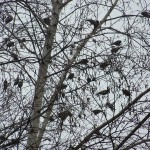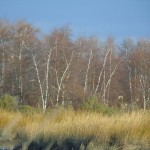- Pine Siskin feeding on birch catkins in Losen Slote, Little Ferry
- Red-polls feed on birch tree catkins at Losen Slote, Little Ferry
- Gray birches at Mill Creek, Secaucus
Robert Frost wrote in his poem “Birches” that “One could do worse than be a swinger of birches.” As much value as birch trees might be to your exercise regime, they are one of the most beneficial trees you can plant to help wildlife.
Seeds produced by the “catkins,” or seed clusters, attract many bird species such as our State Bird, the American Goldfinch. In fact, if you were to take a catkin and tap it in the palm of your hand, you would see many tiny seeds very similar to the commercially available thistle or nyger seed used for finch feeders. Besides our goldfinch, irruption birds such as Redpolls, Purple finch and Pine siskins relish the tiny seeds that are important to their survival.
In addition to finches, Chickadees, Fox Sparrows and Tree Sparrows can also be found dining at birch trees. One of my fondest birding memories is sitting under a stand of Gray Birch at the Delaware water gap many years ago and watching the Ruffed Grouse feeding on the birch seeds that had fallen to the ground, a very rare sight these days.
As important as the seeds are to wildlife, the ultimate value of the birch trees may be the insects that are drawn to them. In fact, there are at least several hundred species of Lepidoptera ( moths and butterflies) that utilize our birch trees. Birch trees are a host plant for butterflies like the beautiful Mourning Cloak and for some of our most magnificent moth species like the Cecropia, Polyphemus and the seldom seen Luna Moth. This makes the birch trees not only important to the moths and caterpillars but equally valuable to the vast numbers of bird species which feed on the insects, for both their nestlings and their sustenance for migration.
We have about five species of Betula, or birch trees, in the northeast: Yellow Birch (Betula alleghaniensis), Sweet Birch (Betula lenta), River Birch (Betula nigra), Paper Birch (Betula papyrifera) and Gray Birch (Betula populifolia), all unique and beautiful and all of which benefit wildlife.
This spring, when planting time arrives and you are looking for a new tree or two to add to your home wildlife garden, consider our native birch trees. They are beautiful, low maintenance and give our wildlife a big helping hand.



